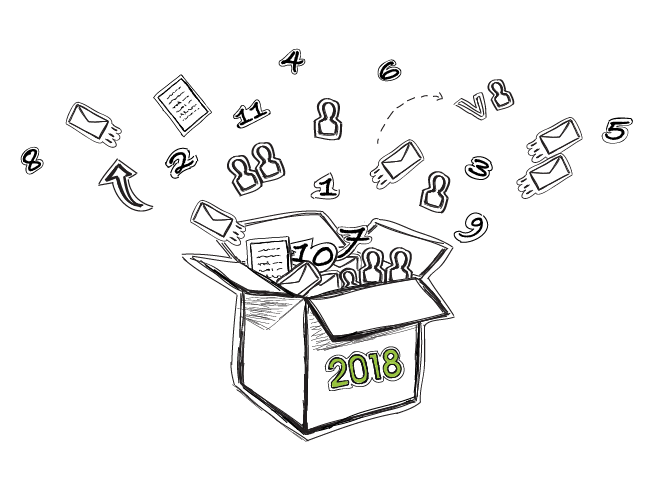We’ve got 2018. It’s been 7 years since the publication of Predictable Revenue. Whereas the basic presumptions about sales and growth made in the book are still valid, outbound messaging has changed a lot over the years. What used to work fine for email outreach in 2011, probably won’t work as well nowadays.
If you feel like outbound lead generation and proactive selling are not working for you as well as they are praised to be working, you should catch up with the ongoing changes taking place in outbound sales. Here’s what to pay attention to in your cold outreach to make it work in 2018.
1. Find new watering holes to look for prospects
It’s not fact-based statistics, but I feel like at least 90% of people doing outbound build their prospect lists using exclusively LinkedIn. Yay for LinkedIn. Boo for the cold email senders and their recipients.
Don’t get me wrong, I don’t say we should forget about LinkedIn. I’m just suggesting we all should stop for a minute and think about other places where we can find companies and people who match our ICP – aka ‘watering holes’ (I’m borrowing this term from Amy Hoy here). Stop and think about places that will provide you with a better point of reference than “I found on your LinkedIn profile that…”.
No matter what niche you’re in, there are probably at least 3 places on the web (like industry-specific platforms, content directories, social media groups) where you can find people from your ideal target group. In such places, you will also find relevant information about their businesses, their problems, and their needs.
Find those places for yourself, having your ICP in mind. Look for prospects there. Look for some information that you can include in your prospect base and incorporate into your email copy. It’s a way to make your email more customized and relevant. Only then go to LinkedIn to get the data necessary to find and confirm your prospects’ contact details.
If you don’t know where to start, start from this list:
15 Places, Other than LinkedIn, Where You Can Look for Prospects >>
2. Stop dropping leaflets
If you’re sending thousands of generic emails to a non-specified group of prospects, you need to stop. It’s like you were dropping thousands of leaflets from a plane in hope somebody will pick one up and come to you ready to buy. It’s inefficient for at least two reasons:
A) The vast majority of the people who get the leaflets will simply ignore them. But what’s worse, some of them will get angry (quite understandably) because you threw some worthless stuff at them without even asking. Hence, your credibility and reputation as a provider of valuable solutions will suffer.
B) Even if by some reason you gain some interest from the leaflet receivers, you won’t be able to tell if these people are actually prospects (not to mention ideal prospects) or just guys who got curious but will never ever benefit from your solution enough to pay for it.
There is nothing predictable about the leaflet-from-the-plane approach. And outbound is about predictability. Its main advantage is the control over who you want to start a business relationship with.
In the leaflet approach, you have no control. You just close your eyes, cross your fingers, and wait for a miracle. Stop littering people’s inboxes and waiting for a miracle. Start being proactive: hand-pick your ideal prospects, send them personalized, valuable messages. Give them a reason to reply.
3. Stop copying other people’s templates
I know you’ve copied them because they worked for someone else before. But what worked for other people is not necessarily going to work for you.
Moreover, hundreds of people just like you also believed that if a template worked once, it’s bound to work for everyone else until the end of time. And this is why your prospects get dozens of emails that look very much alike. Why would they respond to your “Appropriate person” email if they ignored 9 emails with the very same subject just this week?
Stop buying fairy tales about irresistible templates and bulletproof systems. You’re better than that. Nobody knows your target group the way you do. Use this knowledge and get creative to come up with your own template that will work for your target group.
Don’t be afraid to learn from other senders’ experience. Read the templates, analyze message patterns, be open for suggestions, draw from what’s been tested before. But don’t be a copycat who just mindlessly pastes emails that somebody else wrote in a totally different situation.
Here’s more on that: What to Write in an Opening Message to Ace Cold Outreach? >>
4. Focus on your prospect instead of your product
Don’t start your email from a 4-line paragraph about yourself and your mindblowing product or service. Instead, prove to your prospect that you are genuinely interested in their business situation. Write an introduction that will allow you to build a context for your offer afterward.
The most interesting part of your cold email is the part where you talk about the recipient and what they can actually gain by getting back to you. So don’t focus on the features of your solution, but on the benefits for your prospect. I know from experience it may be difficult to tell the difference between the features and the benefits.
Go to this post to learn how to describe your product or service in terms of benefits.
5. Warm-up your prospects before emailing them
Your outreach will work much better if you warm up a contact before dropping them a first line via email. How to warm up your prospects? Use the place where you found them and contribute something they may notice: a comment under their blog post, an answer to their question on Quora, a retweet or a share on LinkedIn or Facebook. Even better if you show some appreciation of their work.
Let them see your face and name, if possible. Set a background for a positive connotation. This way, there’s a chance you’ll look a bit more familiar to them when you finally decide to get into their inbox.
6. Stop selling in the initial email outreach
If you expect your prospect to read your first email, go to your website and buy right away, you seriously need to revalue your expectations from outbound. You’re not supposed to sell in the cold email. If you’re trying to, your prospects may see you as self-interested and pushy. And these are not the traits of a person you want to build relations with or make business with.
The aim of your message should be to intrigue your prospect, attract them, help them, invite them to start a valuable business relationship. That’s all.
The selling part requires much more than just 3 emails. The sooner you realize and respect that, the sooner you’ll be able to create email campaigns that bring you replies and leads.
7. Stop sending selfish follow-ups
That is a difficult task indeed. But you need to remember that every message you send to your ideal prospect should bring them some additional value. How to do that?
Firstly, you may check your opening message and see if there are some arguments, examples, or benefits that could be moved to a follow-up. If so, you can make your first email shorter, and thus easier to read through and process, and at the same time save some of your ammunition for the follow-ups.
Secondly, you can think of presenting your solution in light of different benefits. For instance, if you referred to saving time in your first email, perhaps you could show the gain in terms of money in the follow-up. Be specific. Use real examples and numbers, if possible.
Thirdly, you can check if your prospect didn’t get scared off by the next step you proposed. If you wanted to set up a call from the very beginning, and they didn’t respond to that, maybe the call was too much for them. Perhaps they could answer a simple question via email first. Use the follow-up to ask them the question. Take little steps and learn as much as you can about your prospect group in the process.
8. Test more than one version of your campaign
If you sent one campaign and it just didn’t work, it’s not a reason to give up. Analyze the data you got from this campaign: the open rates, the reply rates, interest rate and the content of all replies. Draw some conclusions.
Next, based on those conclusions, make one significant change and send the new version to another batch of prospects. Analyze the data. Draw conclusions. Make another change. Rinse and repeat.
It’s all about testing and improving in outbound, just like it is in inbound. Embrace that approach and be prepared for many alterations before you see satisfying results.
If you’re not sure what metrics you should analyze, check this post:
What Outbound Sales Metrics Should We Track and Why? >>
9. Take a proper care of deliverability
There are a few factors that affect the deliverability of your emails. And these are factors that you can, and you should, control. Decrease the number of bounced messages and make sure your emails won’t get to spam.
The reputation of your domain, your email server configuration, the quality of your prospect base, the copy and the delivery settings of your campaign – all of them have an impact on deliverability.
If you’ve been seeing high bounce rates, or you have a reason to suspect that your emails may get into spam folders, you need to check all of those factors one by one to find the cause and fix it.
Here are a few practical tips on How to Boost Cold Email Deliverability >>
10. Automate delivery, but stay human
Personalized emails are a must. Follow-ups are a must as well. And if you want to send personalized emails at scale, you need to implement automation that allows you to stay human.
If you haven’t had a chance to try Woodpecker yet, click the link below and give it a spin. It connects up to your email. That means your prospects will receive your messages exactly the way they receive regular emails sent by hand: straight to their main inbox, with a full history of previous correspondence.
You’ll regain the time spent on manual sending, and you’ll receive more replies to follow-ups that may get sent automatically for you.
Try Woodpecker free for 7 days >>
11. Be ready to react ASAP when prospects reply
I know it’s email and one of its main advantages is that you can open, read, and react to messages when it’s most convenient for you. But remember that really effective outreach is not about you. It’s about your prospect – from the start till the very end.
So when your prospect sends you an interested reply: the sooner you react, the better. Once you caught their attention, you should keep it and fuel it. Our experience shows that the less time you take to get back to your prospect after they reply, the better the chances of setting up a meeting and developing a lasting business relationship.
12. Start out lean
Cold emailing is a constant learning curve. The tactics that work now will come out of date pretty soon. So you need to be constantly on your toes to make your outreach effective.
And you can make it so by taking a lean approach to cold emailing.
The reasoning is simple. Instead of creating the largest contact list you can, try cutting things down. And instead of writing a long sequence of messages, try to send just 2-3 follow-ups to your initial email.
In other words, keep things small.
Collect dozens of prospects, divide them into small, highly-defined groups and prepare mini-campaigns aimed just at one group at a time.
Try putting different elements of your campaign to the test. For instance, perform a split test to check which subject line has the highest open rates, whether it’s a version A or B. This will help you learn what works and what doesn’t on a particular prospect group. Experiment some more on small groups before you scale your email outreach.
A lean approach takes far less time than the popular ‘go big’ strategy. You can spend 1-2 hours on outbound each day and devote the rest of the day to your to-do list. That’s not bad.
Such an approach has other advantages as well. Because you get in touch with fewer people, you can concentrate on a high-quality prospecting. What’s more, you’re more motivated to get to know everyone on your contact list, and because of that, you have no problem with deciding what to put in a snippet for personalization.
Give a lean approach a try in 2018. Maybe you’ll learn something new about your prospect group?
Read more about a lean approach to cold emailing >>
13. Send your campaigns to selected ICPs
When we’re doing outbound campaigns, we hope to generate the greatest number of leads. So we try to contact as many people as we can. This is understandable.
You may get a positive response rate you hoped for. But the question is, will those relationships last long? They may not. To avoid that, reinvent the way you think about targeting. Focus your outreach only on the prospects who fit your current Ideal Customer Profile.
As your company grows, you should update your Ideal Customer Profile. We’ve recently updated our ICP. Learn how we structured the process here:
How We Actually Reworked Our Ideal Customer Profile >>
14. Check how you present your brand online
It’s 2018 and people turn to Google if they don’t know something. When your cold email appears in your prospects’ inboxes, they are going to google you and your business. They don’t know you. So they will judge whether they can trust you or not with what they find via Google.
Take some time this year to review the information you put out online about yourself and your business. Start from your website. Does it seem legitimate? Would you trust a business that has a page like that? Does your website have a contact form?
Learn more: How to Audit Your Brand’s Online Presence? >>
Review your personal and brand social media profiles as well. As to your personal profiles, make sure they aren’t stuck in your college years but show you in a light you want to be seen in right now.
When it comes to the brand profiles, delete those you don’t use anymore. Otherwise, the person who stumbles upon them may get an impression that you’re out of business or that it doesn’t go as well.
Another way of taking care of your brand online is acquiring customer reviews. Run a campaign to gather customer feedback and publish it online.
All in all, every action you take online for the sake of your brand should reinforce credibility and trustworthiness.
15. Focus on the results, not the metrics
The past year, the articles in which people proudly showed their extraordinary opening and response rate flooded the Internet. The writers wanted to catch the interest of their readers by focusing on the percentage of those two rates.
Those metrics, together with the delivery rate, are helpful in assessing whether your campaign is working or whether you should change something. They help you measure results of split testing, so you can clearly see which version of the two is better.
However, those metrics may quickly turn themselves into vanity metrics — the metrics that put you in a good light and make you feel accomplished, but they don’t necessarily translate into the success of your campaign.
Even though you do want all the metrics to be as high as possible, you can get a lot of opens and replies, but they are mostly negative.
Learn what to do when you see a lot of negative replies:
What to do When You See Negative Replies To Your Cold Emails? >>
You might have won the numbers game but you don’t accomplish what you expected, for example starting a conversation. Thus, your attention should be devoted to the number of positive replies you get.
The highest quality of replies, not their quantity should matter to you.
16. If you send your emails to the EU, comply with GDPR
On May 25th, GDPR becomes legally binding. But businesses should introduce appropriate changes to the ways in which they process personal data even today.
You should take GDPR seriously, especially if you send your emails to the EU member states. You can still send cold emails, but make sure that your data gathering process is transparent and you have a strong reason for contacting every prospect you get in touch with.
Read our guide to GDPR and download a free checklist >>
You can no longer contact every prospect you’ve found. You need to have a valid reason for processing their data. The offer you present should be relevant to their business. And they Similarly, when somebody asks you how you get their email address, you should be able to explain the process step by step.
Also, you should respect their wish to opt out of getting further correspondence from you. So once they write “please, don’t write to me,” you should respect that and stop the emails from coming into their inbox.
Moreover, you cannot process their personal data longer than it’s necessary. The regulation doesn’t specify the exact time, but we recommend deleting their personal data 30 days after the outreach (at the very least.)
The regulation goes much deeper. You need to review your documents, prepare a risk assessment, appoint a Data Protection Specialist… If you want to learn more, read General Data Protection regulation for Email Senders >>
By and large, GDPR will affect how we process personal data of the EU citizens.
Final words
Hope you found on the list above at least one point to improve in 2018. Our team and I will be more than happy to answer all your questions considering email outreach and to help you set things up. Just drop us a line at [email protected] and tell us what you need.
READ ALSO

These Are 6 Tips to Shape Outbound Sales in 2019
It’s almost time to say goodbye to 2018 and welcome 2019. The end of the year is fast approaching. 2018 has flown by and with year-end closing in, it’s time to start making plans for the future. Looking back at the passing year, we can definitely say that there’s been a lot going on; from a worldwide concern about personal data protection, through a data-driven approach to selling, to an all-bound lead generation and “smarketing”.

Cold Email Statistics Based on Sending Over 20M Cold Emails
Over the span of 2 years, Woodpecker has grown a lot faster than we’ve predicted. We have 1000+ customers on board who come from 52 different countries. But what’s more important for today’s blog post, Woodpecker has sent way more than 20 million sales emails throughout all this time.

Getting Started With Outbound Outreach: Are You on the Right Track?
Getting a good grasp of email deliverability from the very beginning is essential not only for the future success of your campaigns but also for your domain safety. I’ve conducted some research to find out what cold email senders should pay attention to when they want to increase their cold email deliverability rate. Let’s see what I’ve found out.

